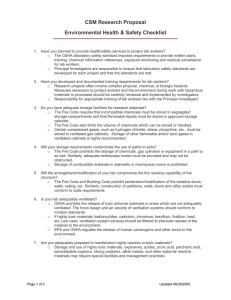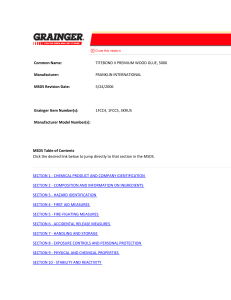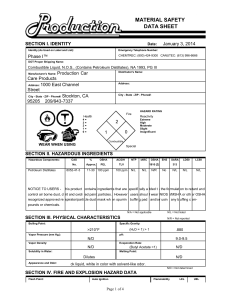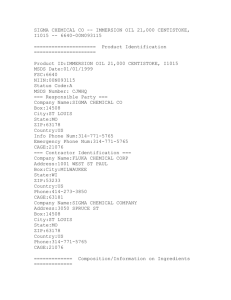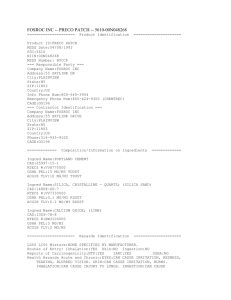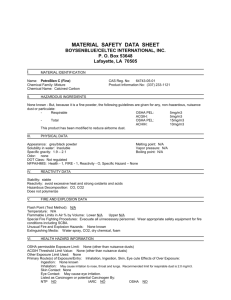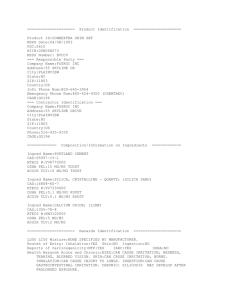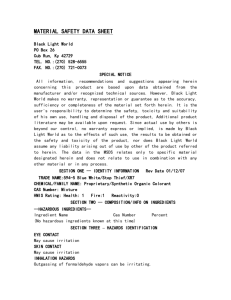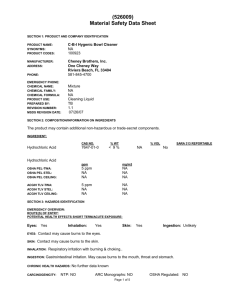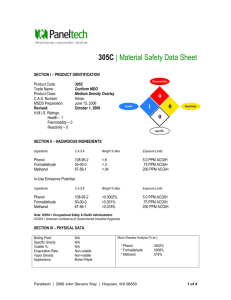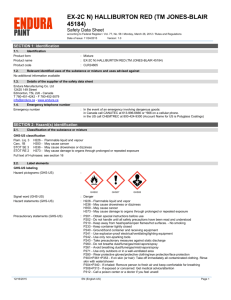MSDS sheet
advertisement
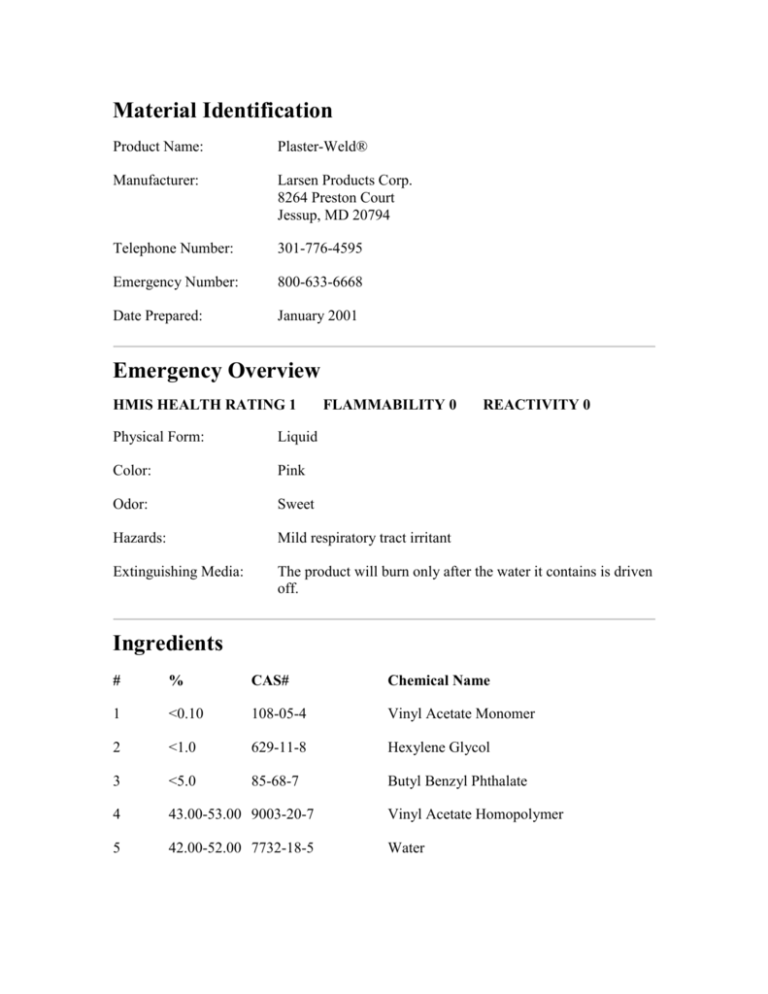
Material Identification Product Name: Plaster-Weld® Manufacturer: Larsen Products Corp. 8264 Preston Court Jessup, MD 20794 Telephone Number: 301-776-4595 Emergency Number: 800-633-6668 Date Prepared: January 2001 Emergency Overview HMIS HEALTH RATING 1 FLAMMABILITY 0 REACTIVITY 0 Physical Form: Liquid Color: Pink Odor: Sweet Hazards: Mild respiratory tract irritant Extinguishing Media: The product will burn only after the water it contains is driven off. Ingredients # % CAS# Chemical Name 1 <0.10 108-05-4 Vinyl Acetate Monomer 2 <1.0 629-11-8 Hexylene Glycol 3 <5.0 85-68-7 Butyl Benzyl Phthalate 4 43.00-53.00 9003-20-7 Vinyl Acetate Homopolymer 5 42.00-52.00 7732-18-5 Water The remaining components are trade secrets, none of which are hazardous or toxic by any known standards. OSHA (ACGIH) EXPOSURE LIMITS 1 2 3 4 5 TWA ppm STEL ppm OSHA 10.0000 20.0000 ACGIH 10.0000 15.0000 OSHA N/E N/E ACGIH 25.0000 N/E OSHA N/E N/E ACGIH N/E N/E OSHA N/E N/E ACGIH N/E N/E OSHA N/E N/E ACGIH N/E N/E N/E = Not Established Health Hazards Routes of Exposure Eye contact Skin contact Ingestion Inhalation Exposure Standards Other: Vinyl Acetate Monomer Dupont TWA = 10.0000 ppm Formaldehyde concentrations in the workplace air may exceed the TLV under certain conditions of use. Under normal conditions of use in a well ventilated space, the concentration of minor components in the workplace air will not exceed the TLV or PEL. See Ingredients Section for exposure standards on ingredients. Maintain air contaminant concentrations in the workplace at the lowest feasible levels. Minor components will migrate into container headspace. Levels in excess of the TLV's or PEL's can accumulate in non-vented container headspaces. Open drums in a well ventilated space. The principal volatile content is water. Minor volatile components are identified in Section "Ingredients". Health Hazards Mild respiratory tract irritant Target Organs None known Signs and Symptoms of Exposure (Acute Effects) Inhalation of vapors may cause irritation in the respiratory tract. Signs and Symptoms of Exposure (Possible Longer Term Effects)Repeated and/or prolonged exposure to low concentrations of vapor may cause: sore throat, which is transient. Medical Conditions Generally Aggravated by Exposure None known Carcinogens Under OSHA, ACGIH, NTP, IARC, Other This product contains no carcinogens in concentrations of 0.1% or greater. First Aid Eye contact Rinse immediately with water. Skin contact Wash affected area with soap and water Inhalation Move patient to fresh air. If breathing has stopped or is labored give assisted respiration (e.g. mouth-to-mouth). Prevent aspiration of vomit. Turn victim's head to the side. Seek medical advice. Ingestion If swallowed, call a physician immediately. Remove stomach contents by gastric suction or induce vomiting only as directed by medical personnel. Never give anything by mouth to an unconscious person. Fire and Explosion Data Flash Point (closed cup): No data Upper Explosion Limit (UEL): No data Lower Explosion Limit (LEL): No data Autoignition Temperature: No data Fire Hazard Classification (OSHA/NFPA): Non-combustible Extinguishing Media: The product will only burn after the water it contains is driven off. For dry polymer use water or carbon dioxide. Product does not burn. Aqueous solution is not flammable. Special Fire Fighting Procedures: No special procedures required. The product, as distributed. is noncombustible. Unusual Fire and Explosion Hazards When dried polymer burns, water (H2O), carbon dioxide (CO2), carbon monoxide (CO) and smoke are produced. Accidental Release Measures Containment Techniques (Removal of ignition sources, diking etc.) Stop the leak, if possible. Ventilate the space involved. Construct a dike to prevent spreading. Clean-Up Procedures If recovery is not feasible, admix with dry soil, sand or non-reactive absorbent and place in a container or dumpster pending disposal. Transfer to containers by suction, preparatory for later disposal. Flush area with water spray. Wash contaminated property quickly before the material dries. Clean-up personnel must be equipped with self contained breathing apparatus and butyl rubber protective clothing. For large spills, recover spilled material with a vacuum truck. Other Emergency Advice Spilled polymer is very slippery. Use care to avoid falls; A film will form on drying. Remove saturated clothing and wash contacted skin area with soap and water. Product imparts a milky white color to contaminated waters. Foaming may result. Wear protective clothing, boots, gloves, and eye protection. Handling and Storage Storage Keep away from oxidizers. Avoid freezing temperatures during storage. Minimize contact with atmospheric air to prevent inoculation with microorganisms. Do not store in iron or other reactive metal containers. Handling Avoid breathing of vapors. Handle in well ventilated workspace. When handling, do not eat, drink or smoke. Avoid contact with skin. Other Precautions Emergency showers and eye wash stations should be readily accessible. Adhere to work practice rules established by government regulations (e.g. OSHA). Personal Protection / Exposure Controls Eye Protection: Chemical safety glasses Hand Protection: Rubber gloves Respiratory Protection: Not required under normal conditions in a well ventilated workplace. An organic vapor respirator National Institute for Occupational Safety and Health (NIOSH) approved for organic vapors is recommended under emergency conditions. Protective Clothing: No specific recommendation Engineering Controls: Maintain air concentrations in work space in accord with standards outline in "Ingredients". Work and Hygienic Practices: Provide readily accessible eye wash stations and safety showers. Typical Physical and Chemical Properties Physical Form: Liquid Color: Pink Odor: Sweet pH: 5.4 Vapor density (mm Hg@21C): 18.62 Vapor density (Air=1): of water vapor Boiling Point: <100 C (<212 F) Melting Point: No Data Solubility in water: Completely (100%) Specific Gravity (Water=1): 1.08 Molecular Weight: Mixture Stability and Reactivity Chemical Stability: Stable at ambient temperatures. Coagulation may occur following freezing, thawing or boiling. Conditions to Avoid (if unstable): Not applicable Incompatibility (materials to avoid): Reactive metals (i.e. sodium, calcium, etc.) Hazardous Decomposition Products (from burning, heating, or reaction with other materials): Depending upon formulation conditions (such as pH), the level of acetaldehyde may increase as a result of hydrolysis of residual vinyl acetate monomer. Carbon monoxide in a fire. Carbon dioxide in a fire. Acetic acid. Aldehydes. Decomposition is insignificant if kept above 200C but below 260 for a short period of time. Above 220C, the polyvinyl alcohol yellows and begins to decompose, toxic cyanates. Hazardous Polymerization: Will not occur. Conditions to Avoid (if polymerization may occur): Not applicable Toxicological Properties Acute Oral Toxicity (LD50, Rat): No data Acute Dermal Toxicity (LD50), Rabbit): No data Acute Inhalation Toxicity (LC50, Rat): No data Other Acute Effects: No data Irritation Effects Data: Non-irritant to the eyes of a rabbit. Non-irritant to the skin of a rabbit. Chronic/Subchronic Data: Although formaldehyde is a minor volatile component of this product, it is important to recognize that recent test results have shown formaldehyde to cause cancer in laboratory animals. Formaldehyde is readily detected due to its irritant properties. The odor detection level varies among different individuals between 0.2 to 1 ppm. In addition, acclimation will occur from repeated exposure but sensitivity returns following rest periods away from the atmosphere containing formaldehyde. Whether a risk exists at levels below the odor threshold has not been determined. Ecological Information No data Disposal Considerations Waste Disposal: Comply with all Federal, State and Local Regulations. For small quantities (less than 100 gallons): Disposal to municipal or industrial wastewater treatment plants is normally acceptable. Obtain approval from these authorities before disposal. The product does impart a white, milky color to water, which may not be removed or sufficiently diluted by the treatment facility. The product may also cause foaming when agitated. The product can be chemically or biologically degraded. For large quantities: Disposal through licensed waste disposal facilities is suggested. The product can be incinerated, though chemical or biological treatment is sufficient. Chemical precipitation/coagulation can facilitate removal of solids (consult manufacturer for detailed procedure). NOTE: As supplied or diluted, product material (foam included), when splashed on automobiles or other personal property, is difficult to remove if allowed to dry. Transport Information DOT Non-Bulk Shipping Name Resin Compound - Not DOT Regulated // Keep from freezing ICAO/IATA Shipping Data Resin Compound - Not IATA Regulated// Keep from freezing Regulatory Information US Federal Regulations Toxic Substances Control Act (TSCA) All components are included in the EPA Toxic Substances Control Act (TSCA) Chemical Substance Inventory OSHA Hazard Communication Standard (29CFR1910.1200) hazard class(es) None EPA SARA Title III Section 312 (40CFR370) hazard class None EPA SARA Title III Section 313 (40CFR372) toxic chemicals above "de minimis" levels None State Regulations Proposition 65 Substances (component(s) known to the State of California to cause cancer and/or reproductive toxicity and subject to warning and discharge requirements under the "Safe Drinking Water and Toxic Enforcement Act of 1986") Formaldehyde Acetaldehyde
